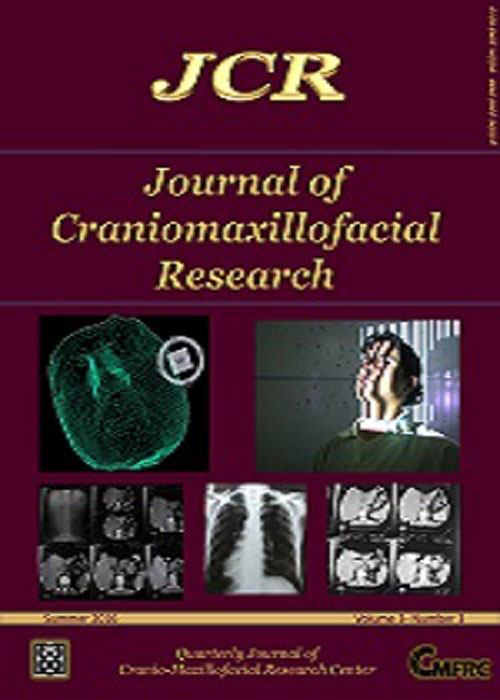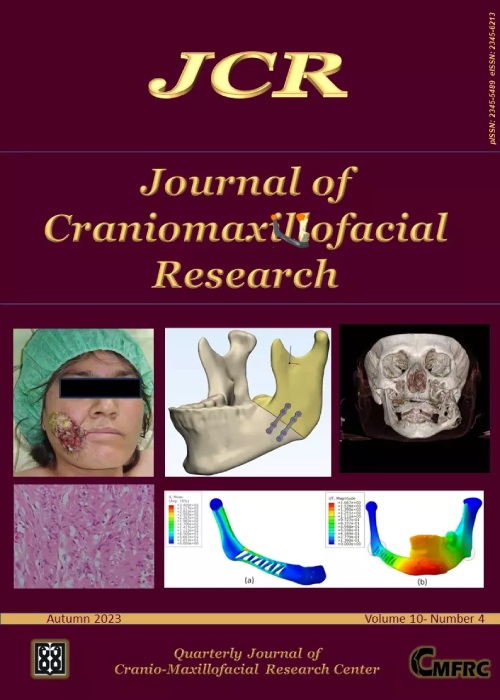فهرست مطالب

Journal of Craniomaxillofacial Research
Volume:3 Issue: 3, Summer 2016
- تاریخ انتشار: 1395/07/20
- تعداد عناوین: 5
-
-
Pages 207-210Introductionone of the most significant concerns after third molar surgery is the post-surgical dental pain. Regarding the efficacy of the Novafen and Naproxen in pain control treatment, it is important to compare the effect of each of these medications to decide which one should be used.
Aim: The aim of this study was to compare the effect of Novafen and Naproxen on pain management in patients after surgical removal of impacted mandibular third molar.
Methods and Materials: This study was a clinical trial that was performed as a split mouth and double-blind on 20 patients (12 females and 8 males) with a mean age of (24.2±5.8) which had surgical extraction of impacted mandibular teeth in two different dates. Novafen (Acetaminophen 325mg, Ibuprofen 200mg, and Caffeine 40mg) and Naproxen 500mg were assessed blindly in each date as a pain control treatment. The pain intensity was determined by VAS (Visual Analogue Scale). In this study, data were analyzed based on Mann-whitney U-tests.ResultsThe mean pain in Novafen group was lower than Naproxen group 4, 8 and 12 hours after surgery (pConclusionThe pain in Novafen group was meaningfully lower than Naproxen group hence Novafen can be used as a more effective therapy rather than Naproxen in dental surgeries.Keywords: Naproxen, Novafen, tooth, impacted -
Pages 211-218IntroductionRecurrent aphthous stomatitis (RAS) is an oral lesion in the form of round or oval, single or multiple painful inflammatory ulcers in the non-keratinized mucosa. The etiology of RAS has not yet to be clearly identified; however, inflammatory process mediated by the action of free radicals and oxidative stress is a possible mechanism. This study aimed to assess the efficacy of propolis for treatment and decrease in frequency of RAS.Materials And MethodsThis triple-blind, placebo-controlled clinical trial was conducted on 45 patients with RAS. Patients were divided into two groups of intervention (n=22, propolis) and control (n=23, placebo). Total antioxidant status (TAS) and level of superoxide dismutase (SOD) and glutathione peroxidase (GPx) of the saliva were measured at baseline and three months after the intervention. Number, size and location of ulcers, pain intensity according to a numerical scale, the healing time and salivary flow rate were assessed at three months compared to baseline. Data were analyzed using Mann Whitney and t-tests.ResultsSignificant differences were noted between the two groups of propolis and placebo and also within each group at three months compared to baseline in terms of number and size of ulcers, the intensity of pain, the frequency of occurrence and the healing time (PConclusionPropolis mouthwash can be effective for prevention and treatment of RAS.Keywords: Antioxidants, Recurrent aphtouse Stomatitis, propolis, Saliva, treatment
-
Pages 219-222IntroductionSurgical removal of inferior third molar tooth is associated with post operative complications such as pain, trismus and edema. Decreasing the post-operative inflammation and edema is one of the important goals in drug administration. For management of post operative pain, nonsteroidal anti-inflammatory drugs (NSAIDs) and opioids can be administered. C-reactive protein (CRP) is one of the best paraclinical parameters for evaluation of tissue inflammation.Materials And MethodsThirty one patients aged 18 to 31years old were enrolled and evaluated in this randomized controlled clinical trial. They were classified into two groups, randomly. In one group, NSAID and in the other group tramadol was administered orally, after dental surgery. Blood samples were taken before procedure and 72 hours after procedure for CRP level evaluation.ResultsRegardless of the type of drugs, CRP changes were statistically significant in both groups before and after operation. Elevation of CRP serum level was higher in tramadol group in comparison to Ibuprofen group and the difference was statistically significant. (P.value 0.05).ConclusionThis study has shown that NSAIDs have more anti-inflammatory effect than opioids.Keywords: Third molar surgery, opioid, C, reactive protein, ibuprofen
-
Pages 223-229BackgroundImprovement of facial beauty is a major reason why patients with dentofacial problems opt for orthognathic surgery. People are eventually judged by their facial appearance by themselves, their friends & family and even surgeons. With the recent developments in technology, we now have a 3D structure that can build and analyze 3D images before & after surgery and review the extent of changes taken place. Imaging techniques include: structured light photogrammetry, CT scan, 3D cephalometry, CBCT and other methods such as MRI and ultrasound. Structured light photogrammetry Using photography cameras (visible range) without any harmful radiation with 3D modeling of the face with high precision. The automatic operation of this procedure reduces human error and yields more accurate final results.Materials And MethodsA before & after clinical trial was conducted. Twenty four patients (17 females & 7 males) who were candidates of orthognathic Bimax surgery as a result of Class III malocclusion and who had attended Shariati Hospitals Maxillofacial Clinic were included in the study. The patients surgical planning was the Lefort I osteotomy Mandibular bilateral sagittal split osteotomy (BSSO). Photography was done through the photogrammetry method.Results3D modeling of the patients faces was done before & after surgery by photogrammetry. Changes following surgery were determined and their formula was calculated.ConclusionsThe resultant mathematical model can be used to build software for the 3D prediction of soft tissue changes following orthognathic surgery. However, it is better to evaluate the validity of the software and mathematical model in a separate study to apply the necessary changes if need be.Keywords: orthognathic surgery, photography, photogrammetry, 3D face modeling
-
Pages 230-234Metastatic lesions represent 1-8% of all malignant tumors of the mouth and jaws, which are regarded as rare sites of metastases from different primary tumors. Metastases in mouth soft tissue are also rare, and within these it is on the gums where they more frequently occur. Primary tumors which metastasize to the mouth are most commonly: lung, breast, and kidney. Clear cell carcinoma is the most frequent cancer of the kidney (60-80% of cases). This tumor has a great propensity to metastasis. We report a case of a 45-year-old man with renal cell carcinoma in which the gingival symptoms (metastatic tumor) preceded the discovery of the primary lesions.Keywords: Clear cell carcinoma, Metastasis, Metastatic tumor, Oral metastatic carcinoma, renal cell carcinoma


